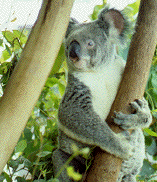
Biology textbooks often portray marsupials
as being primitive animals. For example, Miller and Harley in Zoology: The
Animal Kingdom characterize metatherians (marsupials)
as having a "primitive placenta" while eutherians have "complex placentas.
Dr. Carrick indicated why this view
is quite untrue. For example, kangaroos are very recently
evolved fairly recently and have the most sophisticated lactational
physiology and temperature regulation known for any mammal.
Dr. Carrick's final lecture was given at the University of Queensland Vet Farm in Pinjarra Hills, about a 25 minute ride from the main campus at St. Lucia. After the lecture, we were able to have a first hand look at the Koala Study program run at the Vet Farm by Dr. Carrick. Among other things, the program cares for koalas that have suffered injuries (usually from encounters with cars or dogs) or that are ill with some other disease.
Dr. Frank Carrick with one of the koalas in the rehabilitation
program.
| Sub-class Prototheria | Sub-class Metatheria | Sub-class Eutheria |
| Order Monotremata | Order Diprotodonta | Order Carnivora |
| Order Polyprotodonta | Order Cetacea | |
| Order Chiroptera | ||
| Order Pinnipedia | ||
| Order Primates | ||
| Order Rodentia | ||
| Order Sirenia |
There are also several feral mammals (including camels, cats dogs, donkeys, hares, horses, pigs, and rabbits) with populations established in the wild, but these will not be considered in the notes that follow.
Eutherians: Many of the native eutherian mammals are very interesting. They include the following species: Dugong, Coconut Rat, Giant Rabbit Rat, Water Rat, Flying Foxes, and Ghost Bat.
Monotremes: There are three kinds of living monotremes: Platypus, Short-beaked Echidna, and Long-beaked Echidna (now only found in New Guinea). Although their best known feature is egg laying, they have other unique features such as electro-receptors in their snouts and the males have poison spurs on their heels.
Marsupials: Although biology textbooks often talk about marsupials as being primitive animals, this is quite untrue. For example, Kangaroos have evolved fairly recently and have the most sophisticated lactational physiology and temperature regulation known fora ny mammal. Most of the characteristics which distinguish marsupials are reproductive or embryological. A major characteristic is that they produce very small young after a short pregnancy, which is less than the length of the oestrous cycle.
The Australian marsupials can be subdivided into two major groups on the basis of their dentition: polyprotodonts, which are mostly carnivores and insectivores, and diprotodonts, which are mostly omnivores and herbivores. There is a great diversity of marsupials. Even though there are no "marsupial bats" or "marsupial whales," virtually every other mammalian lifestyle has been evolved by marsupials now or in the past.
| Polyprotodonts | Diprotodonts |
| Common Planigale, Common Dunnart, Brown Antechinus, Yellow-footed Antechinus | Pygmy Possum, Feahtertail Glider, Sugar Glider |
| Polyprotodonts | Diprotodonts |
| Numbat, Kowari, Phascogale, Tiger Quoll, Long-nosed Bandicoot, Brown Bandicoot, Bilby | Squirrel Glider, Fluffy Glider, Greater Glider, Common Ringtail Possum, Green Ringtail Possum, Herbert River Ringtail, Common Brushtail Possum, Rufous Bettong, Potoroo, Brush-tail Rock Wallaby |
| Polyprotodonts | Diprotodonts |
| Tasmanian Devil, Thylacine | Koala, Northern Hairynosed Wombat, Red-legged Pademelon, Yellow-footed Rock Wallaby, Red necked Wallaby, Swamp Wallaby, Wallaroo, Eastern Grey Kangaroo, Red Kangaroo |
Strahan R. Ed. The Mammals of Australia. Sydney, Reed Books. 1995.
Class: Mammalia Subclass: Theria Infraclass: Metatheria Species: Thrichosurus vulpecula "Common Brushtail Possum"The common brushtail possum is a medium sized diprotodont with a body length of 500 mm, tail length of 380 mm, and a weight of 4 kg. They are the most commonly encountered Brisbane marsupial. They are nocturnal and are found in either wet or dry forests. (Photo taken on the UQ campus.)
Class: Mammalia Subclass: Theria Infraclass: Methatheria Species: Pseudocheirus peregrinus "Common Ringtail Possum"The common ringtail possum is another medium sized diprotodont with a body length of 350 mm, tail length of 350 mm, and a weight of 4 kg. They are common even in inner city suburbs, parks, along watercourses, and in backyard gardens. They are nocturnal and feed on flowers or leaves. (Photo taken on the UQ campus.)
Class: Mammalia Subclass: Theria Infraclass: Methatheria Species: Thylogale thetis "Red-necked Pademelon"The red-necked pademelon is a somewhat larger diprotodont with a body length of 500 mm, tail length of 400 mm, and a weight of 6 kg. They are common in restricted habitats of rainforest and vine thickets. They are nocturnal and because they graze on grass they are encountered more frequently than most other pademelons. (Photo taken at Lamington National Park.)
Class: Mammalia Subclass: Theria Infraclass: Methatheria Species: Macropus parryi? "Whiptail Wallaby?"The whiptail wallaby is a larger diprotodont with a body length of 90 cm, tail length of 94 cm, and a weight of 16 kg. They are common on ranges and grassy slopes outside of Brisbane. They are diurnal and are usually seen in mobs. (Photo taken at Beerwah Golf Course on the Sunshine Coast 100km north of Brisbane.)
Class: Mammalia Subclass: Theria Infraclass: Methatheria Species: Macropus gigantus "Grey Kangaroo"The grey kangaroo is a large diprotodont with a body length of 1 m, tail length of 90cm, and a weight of 50 kg. They are uniform woolly grey-brown with a black-tipped tail. They are now uncommon. (C. Parker '98: Photo taken at Lone Pine Sanctuary, Brisbane.)
Class: Mammalia Subclass: Theria Infraclass: Methatheria Species: Phasolarcotis cinerus "Koala"The koala is a somewhat larger diprotodont with a body length of 90cm and a weight of 6kg. It is not commonly seen in the greater Brisbane area. Its nocturnal and feed mainly on the leaves of certain gum trees. Dogs, cars and guns are the main threats. In two six-month visits, the only koalas in the wild I saw were at Noosa, 200km north of Brisbane. (Photo taken at U Q Vet Farm in Pinjarra Hills.)